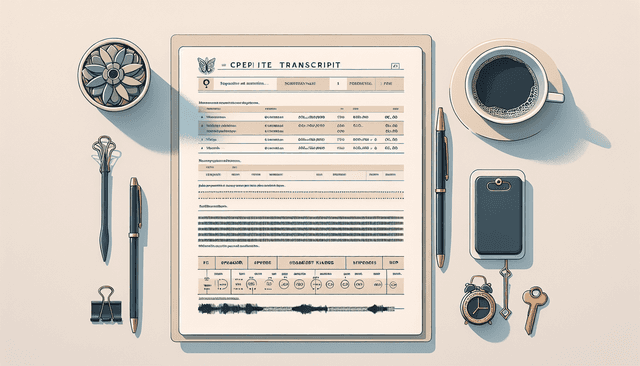Table of Contents
Writing a transcript can feel overwhelming, especially when you’re staring at a long recording. It’s easy to wonder where to start and how to make sure you capture everything accurately. You’re not alone in this struggle!
But fear not! If you stick around, you’ll discover a step-by-step guide that breaks it all down. From understanding the different types of transcripts to the tools you can use, we’ve got your back to make this process smoother and less stressful.
We’ll touch on essential tips for accuracy, common pitfalls to avoid, and how to format your final product. So, grab a snack, and let’s dive into this transcript adventure together!
Key Takeaways
- Choose your material carefully and listen actively to understand the nuances before transcribing.
- Differentiate between verbatim, intelligent verbatim, and summary transcripts based on your needs.
- Utilize transcription tools like Otter.ai or Rev.com for efficiency, or use Google Docs for manual transcription.
- Create a distraction-free workspace and use quality audio for better accuracy during transcription.
- Proofread carefully and format consistently to enhance readability and professionalism.
- Avoid common mistakes like rushing, neglecting to double-check names, and skipping proofreading.
- Choose the right transcript format based on your audience and purpose for better results.

Step-by-Step Guide to Writing a Transcript
Writing a transcript involves several clear steps that make the process manageable and efficient.
First, you need to select the material you want to transcribe, whether it’s audio from a lecture, an interview, or a podcast.
Next, actively listen or watch the content to catch the nuances and emotions that are often lost in writing.
As you go along, jot down key points, speaker identifiers, and time stamps if necessary, which will help you during the transcription.
Once you’ve gathered your notes, it’s time to start typing out the full transcript, aiming for accuracy while capturing the speaker’s intended meaning.
After that, review your work for any errors, making sure it flows naturally and is easy to read.
Finally, save your document in a format that meets the needs of your audience or client, whether that’s a Word document, PDF, or plain text file.
Understanding the Types of Transcripts
Not all transcripts are created equal, and it’s crucial to know the different types out there.
Verbatim transcripts capture every single word, sound, and pause, making them ideal for legal proceedings or detailed interviews.
Intelligent verbatim transcripts, on the other hand, clean up the dialogue while maintaining the essence and context, which works well for podcasts or casual interviews.
Summary transcripts provide a condensed version of the content, perfect for meeting notes or quick updates.
Depending on your purpose, choose the type of transcript that meets both your needs and the expectations of your audience, as each serves a distinct function.
Tools and Software for Transcribing
Utilizing the right tools can make transcription a breeze, saving you loads of time and headaches.
First off, consider using transcription software like Otter.ai or Rev.com, which can automatically transcribe audio for you.
If you prefer to do it manually, text editors like Microsoft Word or Google Docs are great options, as they provide a familiar space for editing and formatting.
Don’t forget about foot pedals, which can help control audio playback while you type, allowing for seamless transcription.
Finally, pairing your tools with noise-canceling headphones can ensure you catch every word clearly, especially in a busy environment.
Tips for Accurate Transcription
Accuracy is key in transcription, and there are several tips to improve your precision.
Start by creating a distraction-free workspace to help maintain focus on the audio material.
Use a high-quality audio file—poor quality can lead to misunderstandings, so make sure the sound is crisp and clear.
Set your playback speed to a comfortable level; sometimes it’s better to slow down and grasp what’s being said rather than trying to keep up with fast speech.
Regular breaks can prevent fatigue—long sessions may impair your ability to catch every word correctly.
Finally, revisit and cross-check any unclear sections with the original audio before finalizing your transcript.

Formatting Your Transcript
Formatting your transcript correctly sets a professional tone and makes it easier for your audience to read.
Start by selecting a clear font like Arial or Times New Roman in 12-point size, as this ensures readability.
Use a consistent layout by including speaker names and time stamps clearly marked, which helps in differentiating between speakers.
For verbatim transcripts, remember to include filler words like “um” or “uh” only if they significantly affect the context.
Indent each new speaker’s dialogue to show a change in voice, and utilize line breaks for easier reading.
Also, ensure that the document is double-spaced to enhance clarity and allows for notes in the margins if needed.
Finally, don’t forget to proofread for formatting errors—I mean, you wouldn’t want that awkward page break ruining your hard work!
Common Mistakes to Avoid When Writing a Transcript
Let’s face it, we all make mistakes, but when it comes to transcription, avoiding certain pitfalls is key.
One common error is neglecting to double-check names, technical terms, or jargon relevant to the subject matter; no one wants to mispronounce an important name.
Another mistake is failing to format consistently, which can confuse readers and detract from the professionalism of your work.
Some transcribers forget to listen to the audio multiple times, leading to omissions and inaccuracies that could change the meaning.
Be careful not to rush the process either; taking your time ultimately results in a higher-quality transcript.
Lastly, skipping the proofreading step is a big no-no—you’d be surprised by how many errors slip through unnoticed!
How to Edit and Proofread Your Transcript
Edit and proofreading might sound like a tedious chore, but doing it right can elevate your transcript significantly.
Start by taking a break after completing your initial draft; a fresh pair of eyes often spots mistakes that were missed during writing.
Read the transcript aloud to catch awkward phrasing or errors that sound clear in your head but don’t translate well to paper.
Use tools like Grammarly for grammar checking, but remember they aren’t foolproof—always apply your judgment.
Compare your transcript against the original audio to ensure accuracy; focus on any sections that sound off or are unclear.
If possible, have someone else review your work; a different perspective can highlight issues you might miss.
Finally, don’t just check spelling and grammar—look for clarity, tone, and flow to make sure it reads smoothly.
Examples of Different Transcript Formats
Understanding various transcript formats can help you present your work in the most appropriate way for different contexts.
A verbatim transcript generally includes every utterance, including filler words, as that completeness is often required in legal settings.
Conversely, an intelligent verbatim transcript keeps the essence while removing unnecessary hesitations and fillers, ideal for podcasts.
Summary transcripts condense the information into key points or highlights, often used in meeting notes or briefings.
For academic purposes, you might use a structured format that not only lists dialogue but also includes references to the material and any visuals used during the presentation.
Additionally, depending on your audience, you can style the transcripts differently; for instance, transcripts aimed at academia may require citations, while those for entertainment can have a more casual presentation.
Ultimately, choose a format that best meets your audience’s needs and the purpose of the document.

Finalizing Your Transcript for Submission
Once you’ve completed your transcript, it’s important to make sure it’s polished before you submit it.
Start by revisiting your formatting to ensure it aligns with the submission guidelines provided by your audience or client.
Convert the file format to match their requirements, whether that’s a PDF, Word document, or another format, as each type serves its own purpose.
Consider adding a title page or a cover letter if the submission is formal; it helps set a professional tone.
Gather any supplementary materials or references that should accompany your transcript to enhance its credibility.
Lastly, double-check the submission method to make sure you’re sending it through the correct channel, whether that is email, a submission portal, or printed material.
FAQs
A transcript is a written record of spoken content, essential for documentation, legal purposes, and accessibility. It helps in providing clear references and supporting written communications, making it vital in various fields.
Popular tools include transcription software like Otter.ai, Rev, and TranscribeMe. These tools utilize voice recognition technology and manual editing options, helping users create accurate transcripts efficiently.
To ensure accuracy, listen carefully, avoid distractions, utilize playback features, and verify names or specialized terms. Additionally, proofreading afterward can help catch errors and improve the overall quality of the transcript.
Professional transcripts should include clear headings, speaker labels, timestamps if necessary, and consistent font usage. Proper spacing and organization enhance readability and help maintain a formal structure.



